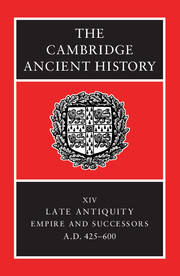Book contents
- Frontmatter
- PART I CHRONOLOGICAL OVERVIEW
- PART II GOVERNMENT AND INSTITUTIONS
- PART III EAST AND WEST: ECONOMY AND SOCIETY
- PART IV THE PROVINCES AND THE NON-ROMAN WORLD
- 18 The north-western provinces
- 19 Italy, A.D. 425–605
- 20 Vandal and Byzantine Africa
- 21a Asia Minor and Cyprus
- 21b Syria, Palestine and Mesopotamia
- 21c Egypt
- 22a The Sasanid monarchy
- 22b Armenia in the fifth and sixth century
- 22c The Arabs
- 23 The Balkans and Greece 420–602
- PART V RELIGION AND CULTURE
- Conclusion
- Chronological Table
- BIBLIOGRAPHY
- Index
- References
19 - Italy, A.D. 425–605
from PART IV - THE PROVINCES AND THE NON-ROMAN WORLD
Published online by Cambridge University Press: 28 March 2008
- Frontmatter
- PART I CHRONOLOGICAL OVERVIEW
- PART II GOVERNMENT AND INSTITUTIONS
- PART III EAST AND WEST: ECONOMY AND SOCIETY
- PART IV THE PROVINCES AND THE NON-ROMAN WORLD
- 18 The north-western provinces
- 19 Italy, A.D. 425–605
- 20 Vandal and Byzantine Africa
- 21a Asia Minor and Cyprus
- 21b Syria, Palestine and Mesopotamia
- 21c Egypt
- 22a The Sasanid monarchy
- 22b Armenia in the fifth and sixth century
- 22c The Arabs
- 23 The Balkans and Greece 420–602
- PART V RELIGION AND CULTURE
- Conclusion
- Chronological Table
- BIBLIOGRAPHY
- Index
- References
Summary
In 425, in the circus at Aquileia, the emperor Valentinian III watched the ritual humiliation and execution of the defeated usurper John. This bloody spectacle celebrated the restoration of Italy to its rightful place as the centre of Roman imperial rule after two years of secessionist government. Less than two centuries later, in 605, the Constantinopolitan emperor Phocas ratified a series of treaties with the Lombards which acknowledged, implicitly if not explicitly, that large areas of Italy had been lost to imperial rule. Between these events occurred the dismemberment of Roman Italy, together with its increasing marginalization in the empire. At the outset of this period, Italy was still the centre of the empire; by its end, however, it had become a frontier province, fought over by Lombard potentates and Byzantine military governors.
This chapter will trace this political fragmentation and show how it was reflected in the transformation of local society throughout Italy. The political disintegration has long been known. Certain stretches of Italian history in the fifth and sixth century are narrated in detail by contemporary historians and chroniclers, although overall the coverage is rather patchy, while the epistolary, exegetical and hagiographical works of Gregory the Great present a haunting vision of Italy after decades of debilitating wars. At an institutional level, the letters of Cassiodorus give valuable insights into the administration of Ostrogothic Italy, while inscriptions, though not so numerous as for earlier periods, add further detail to the picture, announcing the ambitions of rulers or recording the achievements of local aristocrats.
- Type
- Chapter
- Information
- The Cambridge Ancient History , pp. 525 - 551Publisher: Cambridge University PressPrint publication year: 2001
References
- 2
- Cited by



